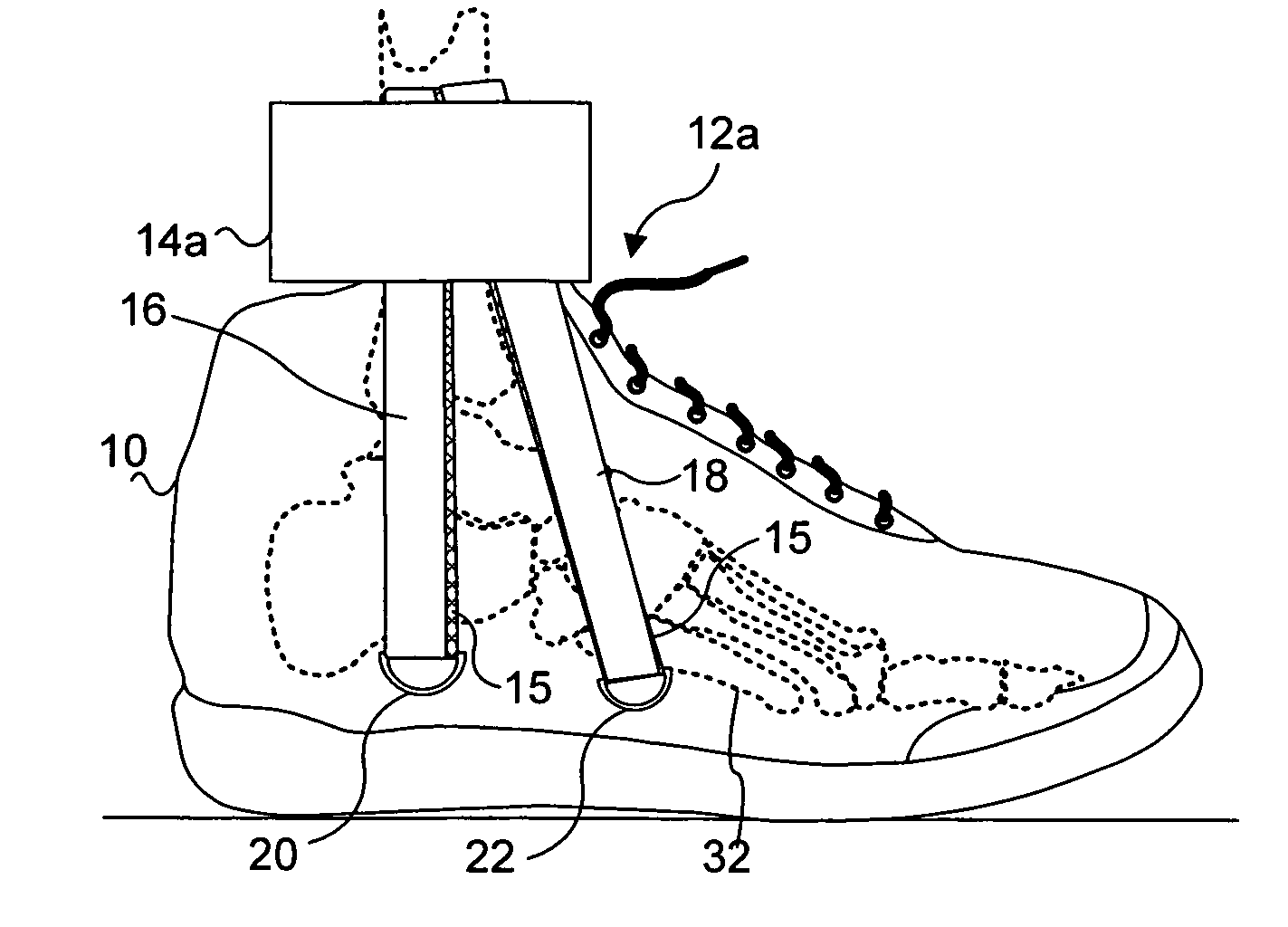Ankle and foot stabilization support
a technology for supporting the ankle and the foot, which is applied in the field of ankle and foot stabilization supports, can solve the problems of not providing any support for the forefoot, spraining, and incurring or being susceptible to ankle injuries, and achieves the effect of preventing ankle sprains
- Summary
- Abstract
- Description
- Claims
- Application Information
AI Technical Summary
Benefits of technology
Problems solved by technology
Method used
Image
Examples
first embodiment
[0029]FIG. 1 shows a lateral ankle and foot stabilization support apparatus. Lateral ankle and foot stabilization support 12 includes an ankle collar 14, a first tension band 16, and a second tension band 18. Ankle collar 14 is shown unfastened, and disposed adjacent to an upper collar of an item of footwear 10. Ankle collar 14 functions as a support foundation that is removably attached to a user's leg proximate to the user's ankle malleoli. As will be described below, a plurality of tension bands engage both the support foundation and the item of footwear. Those of ordinary skill in the art will recognize that, in addition to the ankle collar shown in FIG. 1, other types of support foundations could be utilized. For example, as opposed to the strap based collar shown, a clam shell type support foundation (not separately shown) could be employed. The specific implementation of the support foundation is not critical, and in some instances, it may be desirable to incorporate the supp...
second embodiment
[0034]FIG. 2 illustrates a lateral ankle and foot stabilization support 12a shown without an item of footwear, and shows the details of ankle collar 14a. The ankle collar is designed to be secured around the user's lower leg. Preferably, it will be disposed at a point proximately above the ankle malleoli so that it rests against the ankle malleoli in order to gain purchase and not slide down the user's leg. Ankle collar 14a includes a hook portion 15 and a loop portion 13, enabling ankle collar 14a to be removably attached to a user's leg. Of course, the relative positions of the hook and loop portions can be reversed, as already noted. In this embodiment, upper strap 26a is pulled around to encircle the user's leg and its loop portion 13 will engage its hook portion 15 with enough tension so that ankle collar 14a will not slip off or slide down when tension bands 16 and 18 are loaded with the desired tension. Ankle collar 14a is sufficiently long to be secured about a wide range of...
third embodiment
[0045]FIG. 5 illustrates support 12c, the invention, in which the plurality of tension bands are configured to support a medial side of the user's foot. When properly positioned, these medial tension bands support at least the navicular tuberosity and the posterior tibial tendon.
[0046]A tension band 44 has a first end attached to ankle collar 14c. When properly adjusted, tension band 44 extends from ankle collar 14c to a D-ring 54, where the tension band slidingly engages the D-ring, and then extends back to ankle collar 14c. As discussed above, once a desired tension has been loaded on a tension band (by engaging the tension band with the D-ring, and pulling the tension band back toward the ankle collar), the tension band can be secured in a number of different ways, such as by attaching a free end of the tension band to the ankle collar, attaching the free end of the tension band to the underlying portions of the tension band using hook and loop fasteners, using a buckle, or a com...
PUM
 Login to View More
Login to View More Abstract
Description
Claims
Application Information
 Login to View More
Login to View More - R&D
- Intellectual Property
- Life Sciences
- Materials
- Tech Scout
- Unparalleled Data Quality
- Higher Quality Content
- 60% Fewer Hallucinations
Browse by: Latest US Patents, China's latest patents, Technical Efficacy Thesaurus, Application Domain, Technology Topic, Popular Technical Reports.
© 2025 PatSnap. All rights reserved.Legal|Privacy policy|Modern Slavery Act Transparency Statement|Sitemap|About US| Contact US: help@patsnap.com



